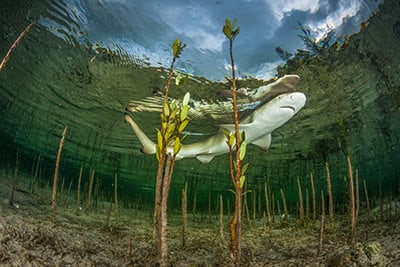Shark Reproduction
About 70% of all shark species give birth to live young, the other species lay eggs. Most shark species reach sexual maturity very late, some, like the spiny dogfish, only after well over 15 years. Some shark species mate all year round. Others prefer certain seasons and areas. The females of some shark species produce young every year, while others take regular or irregular reproductive breaks of several years. This diversity of reproductive strategies has so far made sharks so very successful.
But as hunters, sharks generally reproduce much more slowly than bony fish. This is their downfall today. Many species can no longer compensate the losses they suffer on all fronts with their offspring.

Photo © BPA
Mating
All sharks have a safe, internal fertilization, while many bony fish release their eggs and sperm unprotected into the seawater.
The mating game of sharks is generally rather rough. For the transfer of sperm they have to lie stomach to stomach, which is not easy in the water. Often the males bite the pectoral fins of the females to have more hold because the skin there is particularly firm and stable. Once the male is in position, he transfers a sperm packet into the female's cloaca with one of his claspers. The large claspers are a distinctive feature of male sharks.
For some shark species polyspermy occurs, i.e. several males mate with one female. The female then decides the timepoint and precisely which sperm fertilizes the eggs.
In aquariums, parthenogenesis (virgin birth or egg development without sperm) has even been observed.

Photo © BPA
Egg-laying sharks
About 30% of sharks lay eggs. The eggs are elongated and enclosed by a horny, coarse and often interestingly shaped egg capsule. The egg capsules have filamentous outgrowths that serve to anchor them to aquatic plants or other objects. Usually the eggs are quite large, 5 to 25 cm long. They contain a lot of yolk to ensure that the embryos are richly supplied with nutrients. Depositing the young animals in well-protected, stable egg shells with sufficient nutrients shortens the time a female shark is pregnant.

Photo © BPA
Viviparous sharks
About 70% of all sharks give birth to fully developed young. This development is similar in many aspects of mammalian reproduction. The eggs are fertilized in the upper part of the fallopian tubes and have only one thin egg capsule. The females then retain the developing eggs in the dilated end section of the fallopian tube, which is thus also called the uterus. In the protective womb the young develop and are born as independent sharks after a gestation period of 6 to 22 months. The birth size is usually between 30 and 60 cm.

Photo © Shutterstock
Breeding care pays off
Breeding care
In viviparous sharks, the young are born larger and stronger than in egg-laying species. During pregnancy they are protected in the womb from predators, competitors and other dangers. The long gestation period and late sexual maturity result in fewer young per generation. The highly specialized and successful evolutionary reproduction method of sharks is also their doom due to man and his predatory exploitation. Sharks can no longer compensate for their losses.
Nurseries
Shark nurseries provide a safe home for shark babies and guarantee sufficient food. Many of the viviparous sharks give birth to their young in the protective roots of mangrove forests. These nurseries offer plenty of hiding places from hungry predators and conspecifics. Plus there is always enough food for the shark babies there since bony fish also use the mangroves to protect their young.
But the mangrove areas are declining dramatically. In the last 20 years, 35% of the worldwide mangrove forests have been destroyed.












